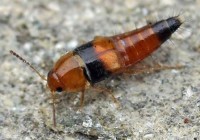By Multimedia On this episode of ID the Future, hear part three of a recent talk Casey Luskin gave on evolution and intelligent design, in which he presents some of the biggest problems with the case for Darwinian evolution. In this segment, Casey discusses how mutations and natural selection don’t produce many of the complex features we see in life. Your browser does not support playing Audio, please upgrade your browser or find our podcast on podOmatic Download Episode …read more Read more here: id the future
By radio@answersingenesis.org (Steve Ham) …read more Read more here: Answers Conversation
By Creation Moments On a previous broadcast, we told you about the IPCC report designed to frighten people with dire warnings about the destruction of our planet if the world’s governments don’t take serious measures now to combat man-made global warming. read more …read more Read more here: Creation Moments
By Creation Moments Meet Wolf-Ekkehard Lönnig, a brilliant scientist who worked at the Max-Planck Institute until his retirement. Though he has written four books on the subject of evolution, he has infuriated evolutionists everywhere by daring to challenge Neo-Darwinism on scientific grounds. read more …read more Read more here: Creation Moments
By Creation Moments What creature lives deep underground, has a dark purple head and a blue-grey body, can grow up to nine feet in length and sounds like a bathtub draining of water? It’s the Giant Gippsland earthworm of Australia, of course! read more …read more Read more here: Creation Moments
By Creation Moments For many years, Creation Moments has been sharing information about the ways that plants and trees talk to one another to protect each other from invaders. Many scientists have ridiculed us for making such outrageous claims. But they’re not laughing any longer. read more …read more Read more here: Creation Moments
By Creation Moments The University of Tübingen’s Institute of Anatomy recently discovered a fish with what they called “a previously unknown type of eye.” The glasshead barreleye has a cylindrical eye pointing upwards to see prey, predators and potential mates. But the eye also has a mirror-like second retina which is able to detect bioluminescent flashes created by deep-sea denizens to the sides and below, reports Professor Hans-Joachim Wagner. read more …read more Read more here: Creation Moments
By Creation Moments Would you believe that life on planet Earth was the result of icy comets striking the Earth’s surface long, long ago? We didn’t think so. But a team of researchers from three distinguished institutions would disagree with you. read more …read more Read more here: Creation Moments
By Creation Moments Graphene may be the most unusual material that will ever be discovered. It has already revolutionized the world of physics and won the 2010 Nobel Prize in physics for physicist Andre Geim and his colleague, Kostya Novoselow. read more …read more Read more here: Creation Moments
By Creation Moments Has Darwin’s dilemma finally been solved? Darwin’s dilemma has been vexing evolutionists for more than 150 years. Charles Darwin, you see, was unable to explain the sudden arrival in Cambrian rock of most of the phyla we have today when no fossil evidence of their ancestors can be found in pre-Cambrian rock. read more …read more Read more here: Creation Moments
By radio@answersingenesis.org (Steve Ham) …read more Read more here: Answers Conversation
By Multimedia On this episode of ID the Future, Casey Luskin responds to Calvin College biology professor Steve Matheson’s critique of Signature in the Cell. What would you get if you crossed a snarky pro-evolution blog like Panda’s Thumb with a passionate defender of theistic evolution? You might get Steve Matheson’s critique of Stephen Meyer’s book. Listen in as Luskin explains how Matheson’s frequent personal attacks on Meyer, mixed with exposés of occasional typos and the possible discovery of one minor error, make for a weak argument against intelligent design. Your browser does not support playing Audio, please upgrade your [More]
By Creation Moments The heart is an amazingly complex organ consisting of muscle tissue. And what do muscles do? They contract when stimulated by electric pulses. Though the human heart will beat 2-3 billion times in a person’s lifetime, heart disease is one of the most common causes of death. That’s why researchers have been looking for a way to produce artificial heart tissue. Have they finally succeeded? read more …read more Read more here: Creation Moments
By Multimedia On this episode of ID the Future, hear part two of a recent talk Casey Luskin gave on evolution and intelligent design, in which he presents some of the biggest problems with the case for Darwinian evolution. In this segment, Casey discusses Darwinism and the origin of life. Your browser does not support playing Audio, please upgrade your browser or find our podcast on podOmatic Download Episode …read more Read more here: id the future
By Multimedia On this episode of ID the Future, hear part one of a recent talk Casey Luskin gave on evolution and intelligent design, in which he presents some of the biggest problems with the case for Darwinian evolution. In this first segment, Casey discusses the often-heard myth that there are no credible scientists who doubt the teachings of Darwinian evolution on the basis of evidence (or lack thereof). Your browser does not support playing Audio, please upgrade your browser or find our podcast on podOmatic Download Episode …read more Read more here: id the future
By Creation Moments As you know, bats are able to find their way around and locate their prey using echolocation – high-pitched sounds that they also use to keep from flying into trees and other bats. But scientists have now learned that one particular kind of bat emits another call that warns other bats to stay away from bugs they’ve claimed for themselves. read more …read more Read more here: Creation Moments
By Multimedia On this episode of ID the Future, Casey Luskin interviews Michael Behe on his peer-reviewed scientific paper in Quarterly Review of Biology. Dr. Behe explains why most examples of evolution in bacteria and viruses entail loss or modification of function rather than gain of a new function at the molecular level. In Behe’s view, this could pose a challenge to Darwinian explanations of molecular evolution. Your browser does not support playing Audio, please upgrade your browser or find our podcast on podOmatic Download Episode …read more Read more here: id the future
By Creation Moments Mechanical gears – like those found in clocks – have been around since the Greeks are thought to have invented them around 300 B.C. But scientists have now discovered a small hopping insect equipped with a set of living gears! read more …read more Read more here: Creation Moments
By radio@answersingenesis.org (Steve Ham) …read more Read more here: Answers Conversation
By Creation Moments How smart are Americans when it comes to science? That’s what the National Science Foundation attempts to find out every two years. The results of their 2014 survey – which included more than 2,200 adults – gave Americans a rather poor grade. But are Americans really less knowledgeable about science or is the NSF’s survey biased against the many Bible-believing Christians in America? Let’s take a look. read more …read more Read more here: Creation Moments
By Multimedia On this episode of ID the Future, hear why the often-heard claim that intelligent design isn’t science is false, as Andrew McDiarmid explains the top reasons why ID is science. Your browser does not support playing Audio, please upgrade your browser or find our podcast on podOmatic Download Episode …read more Read more here: id the future
By Creation Moments Evolutionists tell us a 66-million-year-old feathered dinosaur resembling a giant demonic bird was discovered in the fossil-rich Hell Creek formation of South and North Dakota. Not surprisingly, this newly discovered dinosaur species was dubbed the “chicken from hell”. read more …read more Read more here: Creation Moments
By Multimedia On this episode of ID the Future, hear Casey Luskin’s recent testimony in support of the South Dakota Academic Freedom Bill, SB114. Last month, the bill died in the Senate Election Committee by a vote of 4 to 2. Those who testified in favor of the bill include Dr. William Harris, a biochemist who holds a faculty position at the Sanford School of Medicine at the University of South Dakota, and Casey Luskin, the Research Coordinator at Discovery Institute. Your browser does not support playing Audio, please upgrade your browser or find our podcast on podOmatic <a class="colorbox" [More]
By Creation Moments Are we, as human beings, as good as it gets? According to several influential evolutionary scientists, human beings are as good as it gets, and evolution has stopped for us. Some dispute this, saying that human evolution is still happening, but it’s invisible. Although none of this sounds very much like science, such claims have fueled new debate among evolutionists. read more …read more Read more here: Creation Moments
By Creation Moments We have noted many times the different ways in which bats defy evolutionary explanations. For their echolocation systems to evolve, bats had to develop simultaneously the ability to make high pitched sounds, hear those sounds, and figure out what they mean. How did they eat before they evolved these abilities? Then there is the problem of evolving typical mammalian forearms into bat wings without crippling the creature in the process. Even evolutionists admit that the evolution of all these features even once is highly unlikely. read more …read more Read more here: Creation Moments
By Multimedia On this episode of ID the Future, Casey Luskin examines the convergent genetic evolution of bat and whale echolocation, a surprise to the neo-Darwinian model, as common inheritance makes no sense. Your browser does not support playing Audio, please upgrade your browser or find our podcast on podOmatic Download Episode …read more Read more here: id the future
By Creation Moments Rove beetles are found in the rain forests of Costa Rica and have three different ways of making a living. Their largest prey are the blow flies that frequent animal dung. The beetles wait on the dung for a blowfly to land, then stalk their prey with the skill of a cat. They can even capture their prey in the air if it tries to escape. But dung doesn’t last long in the rain forest, because dung beetles quickly haul it off. read more …read more Read more here: Creation Moments



















![[MIRROR] Biased against design [CMIcreationstation] [MIRROR] Biased against design [CMIcreationstation]](http://img.youtube.com/vi/rz30zs_SQtc/0.jpg)



